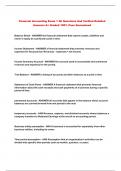Exam (elaborations)
Financial Accounting Exam 1 All Questions And Verified Detailed Answers A+ Graded 100% Pass Guaranteed
- Course
- Institution
Financial Accounting Exam 1 All Questions And Verified Detailed Answers A+ Graded 100% Pass Guaranteed...
[Show more]



